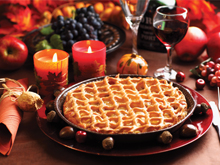Health Topics
-
Healthy Living
-
|
|
November 2011
|
| Foods To Keep Warm And Healthy |
| Prachi Patodia Saraf |
| |
 |
Winter is a great time to enjoy ourselves—we look forward to festive foods, cold weather and holidays to relax. During winter the body needs to produce more heat to stay warm. This is the time our body can benefit from the so-called ‘hot foods’. |
Healthy winter foods
- Brightly coloured fruits and vegetables: Vegetables are a great source of antioxidants, phytochemicals and fibre. Eat vegetables like beetroot, carrot, asparagus and bathua and fresh berries and citrus fruits, like amla and oranges.
- Nuts and seeds: Healthy fats help regulate the body temperature. Good options include walnuts (for omega-3 fatty acids), pistachios and almonds. Flax seeds and pumpkin seeds can be mixed in yoghurt or used as topping on salads.
- Jaggery: Substitute jaggery for sugar in popular sweets like til papdi and nut chikki. It is loaded with vitamins and minerals, especially iron. Kada, which is a mix of jaggery, tulsi,long, black pepper and turmeric powder is good for cough and colds.
- Ghee: When consumed in its pure form, ghee is a healthy fat. It promotes healthy skin, digestion and enhances brain function. Many Indian sweets are prepared with ghee.
- Sarson ka saag: Sarson (mustard greens) is one of the most nutritious green leafy vegetables available only during winter. It is low in calories and is known for its cholesterol lowering ability. It has anti-inflammatory (Vitamin K and Omega-3) and anti-oxidant benefits (Vitamin C, Vitamin E, beta-carotene and manganese) and is known for its anti-cancer benefits.
Other foods include fenugreek, sesame seeds, turmeric, ginger powder, green chillies, saffron and grains like bajra and corn.
Sumptuous soups
Drink a comforting and nourishing bowl of soup this winter. Enjoy as an appetizer or as a full meal. Make your homemade soup tasty yet healthy and filling.
- Lots of vegetables: Load your bowl with colourful vegetables like broccoli, beans and carrots.
- Healthy substitutes: Prepare fresh stock using flavour-enhancing ingredients like lemon and herbs instead of using ready stock cubes (full of preservatives and sodium). Substitute cream for milk. Replace thickening agents like corn flour with soya, moong dal and rajma.
- Healthy protein: Minimize saturated fats by making smart protein choices like lean meats, tofu and soy granules.
Healthy pies
Delicious pies can be healthy as well. Try these quick tips this winter to make pies, which are high in fibre and low in saturated fat:
- Crust: Replace the plain flourwith whole wheat flour or multi-grain biscuits. Use corn oil instead of butter or margarine. Mix chilled water to keep the crust firm. Don’t over knead the dough and keep the dough chilled before you roll it. Use butter paper to roll, which makes transferring to the pan easier.
- Fillings: Pies can be filled with fresh fruits, vegetables, jams, marmalades, cheese and chocolates. Replace cream (used with strawberries) with jelly or gelatin. Another alternate is to use whipped cream thickened with gelatin and non-fat yoghurt to substitute cream. Replace milk chocolate with dark chocolate. Mix skim milk instead of full fat milk. Use low-fat white sauce or tomato based sauces for savoury crepes. Low fat cheese is a tasty option. Grill and sauté colourful winter vegetables.
|
Sarson Ka Saag
A famous,indigenous recipe from north India made calorie-friendly by using minimal ghee and low-fat milk! Also, mustard leaves are considered to be the richest source of Vitamin A, Vitamin C and iron. To decrease the bitter flavour of mustard greens, cook them in boiling water for a minute before sautéing.
Preparation time:15 minutes
Cooking time:30 minutes
Serves:4
Ingredients
5 cups roughly chopped mustard leaves (sarson ka saag)
1½ cups roughly chopped spinach (palak)
2½ tsp finely chopped green chillies
2 tsp finely chopped ginger (adrak)
2 tsp oil/ghee
½ cup finely chopped onions
1 tsp finely chopped garlic (lehsun)
1 cup chopped tomatoes
2 tsp chilli powder
3 tbsp maize flour (makai ka atta)mixed with â…“ cup of water
¼ cup low-fat milk, 99.7% fat-free
Salt to taste
Directions
- Combine mustard leaves, spinach, green chillies and ginger with 1½ cups of water in a broad pan and cook on medium flame till the greens get cooked and the water dries out. Keep aside.
- Blend to a coarse paste in a mixer. Keep aside.
- Heat the oil/ghee in another pan; add the onions and garlic and sauté on medium flame till the onions turn translucent.
- Add the tomatoes and the chilli powder and cook till the mixture leaves oil.
- Add the prepared paste and cook on medium flame for five minutes, while stirring continuously.
- Add the maize flour paste, milk and salt and mix well. Simmer for another five minutes, while stirring continuously.
- Serve hot.
Nutritive Value Per Serving
Energy: 76 calories,Carbohydrates: 7.7 gms,Protein: 4.2gm,Fat: 2.5 gms,
Vitamin A: 3235.3 mcg, Vitamin C: 40.4 mg, Iron: 10.9 mg |
|
 |
Prachi Patodia Saraf is Health enthusiast and marathon runner.She has a Bachelors' in Management from The Wharton School(USA) |
|
|